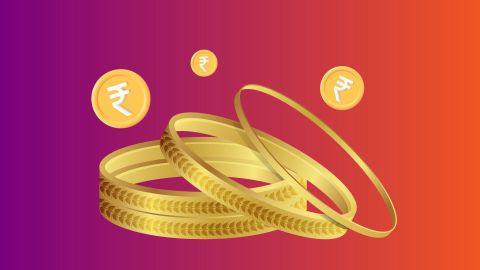Recent trends in gold prices in India
In recent years, gold prices in India have shown a volatile yet upward trend. The COVID-19 pandemic significantly impacted the gold market, driving prices to unprecedented heights in 2020. Since then, the market has experienced fluctuations, influenced by vaccination rollouts, economic recovery, and global geopolitical tensions. In 2021, prices saw some correction, dipping below ₹50,000 per 10 grams, but they have generally remained robust due to ongoing economic uncertainties and inflation concerns. By 2023, gold prices have been trading in the range of ₹47,000 to ₹53,000 per 10 grams, reflecting a cautious investor sentiment and the metal's safe-haven appeal. Additionally, the weakening of the Indian Rupee against the US Dollar has also played a role in sustaining higher gold prices domestically.
Future predictions for gold rate in India
The future of gold rates in India is poised for both opportunities and challenges. Analysts predict that gold prices may remain strong in the short to medium term due to persistent global economic uncertainties and inflationary pressures. The geopolitical tensions, especially in regions crucial to the global economy, and the policy decisions by major central banks, particularly the US Federal Reserve, will play significant roles. Domestically, factors like the Indian Rupee's performance against the US Dollar, changes in import duties, and domestic demand during festivals and wedding seasons will influence prices. Some experts foresee gold prices potentially breaching the ₹60,000 per 10 grams mark if economic conditions worsen, while a stabilising global economy might keep prices in a more moderate range.
Global market influences on Indian gold prices
The Indian gold market is significantly influenced by global market dynamics. The international price of gold, largely determined by the US Dollar strength, global economic health, and geopolitical events, directly affects Indian gold prices due to India's heavy reliance on gold imports. When global gold prices rise, Indian prices follow suit, often compounded by fluctuations in the Rupee-Dollar exchange rate. Additionally, major economic policies and interest rate decisions by the US Federal Reserve impact gold prices globally, thus affecting the Indian market. For instance, during times of global economic crises or geopolitical tensions, the surge in gold's safe-haven demand drives up its price. Conversely, during periods of economic stability and rising interest rates, global gold prices might stabilise or decline, influencing the Indian market accordingly.
How do festivals and weddings impact gold rates?
In India, festivals and weddings have a profound impact on gold rates due to the cultural significance and high demand for gold during these times. Festivals like Diwali, Dhanteras, Akshaya Tritiya, and the wedding season see a surge in gold purchases, which drives up demand and consequently, the prices. During these periods, families invest heavily in gold jewellery, considering it auspicious and a sound investment. The increased demand often leads to a temporary spike in gold prices. This seasonal pattern is a well-established trend in the Indian gold market. Jewellery shops and gold retailers also offer promotions and discounts, further stimulating demand. This cyclical surge in gold purchases around festivals and weddings plays a crucial role in maintaining the overall price stability and growth in the Indian gold market.
Seasonal variations in gold prices in India
Gold prices in India exhibit notable seasonal variations, largely influenced by cultural and agricultural cycles. The demand for gold typically peaks during the festival and wedding seasons, leading to higher prices. For instance, during the months of October to December and April to June, gold prices tend to rise due to increased purchases for Diwali, Dhanteras, and the traditional wedding season. Additionally, the post-harvest period sees rural demand for gold increase, as farmers invest their earnings in gold, considered a safe asset. Conversely, the monsoon months often witness a dip in demand and prices, as agricultural activities dominate and disposable income is lower. These seasonal trends are crucial for investors and traders, providing predictable patterns in the gold market's behaviour throughout the year.
Impact of gold ETFs on price trends
Gold Exchange-Traded Funds (ETFs) have significantly impacted gold price trends by providing an accessible and liquid investment vehicle for investors. Unlike physical gold, ETFs can be traded on stock exchanges, making it easier for investors to buy and sell gold-linked assets without the complexities of storage and security. This increased accessibility has led to a broader participation in the gold market, influencing demand and, consequently, prices. The influx of institutional investors into gold ETFs has also added to this dynamic, as large-scale buying or selling by these entities can lead to substantial price movements. Additionally, ETFs offer transparency in pricing, aligning closely with international gold prices, which helps stabilise and sometimes amplify domestic gold price trends based on global market conditions.
Additional Read: What is the gold inflation rate
Influence of market sentiment on gold prices
Market sentiment plays a crucial role in determining gold prices, as investor behaviour often drives demand and supply dynamics. During times of economic uncertainty, geopolitical tensions, or financial market volatility, positive sentiment towards gold as a safe-haven asset increases, leading to higher prices. Conversely, in periods of economic stability and strong equity market performance, the sentiment may shift away from gold, causing prices to drop. Sentiment is also influenced by inflation expectations, interest rate movements, and currency fluctuations. For example, if investors anticipate higher inflation, they might increase their gold holdings to preserve value, driving up prices. Similarly, negative sentiment towards fiat currencies or concerns over monetary policies can boost gold demand.
How do gold price trends impact gold loan values in India?
Prevailing gold price trends significantly influence the value of loans against gold in India. When gold prices are high, the value of the collateral increases, enabling borrowers to secure larger loan amounts. Financial institutions typically offer loans against gold jewellery or coins, assessing the loan-to-value ratio based on current market prices. Conversely, when gold prices decline, the collateral value reduces, potentially limiting the loan amount and increasing the risk for lenders. This dynamic makes it crucial for both borrowers and lenders to monitor gold price trends closely. High gold prices can lead to an uptick in demand for gold loans, as individuals leverage their gold assets to access capital while falling prices might trigger stricter lending criteria.
Evaluating gold jewellery for loans based on price trends in India
Evaluating gold jewellery for loans in India heavily depends on current gold price trends. Financial institutions assess the purity and weight of the jewellery, multiplying these by the prevailing gold rate to determine the loan amount. The gold loan rate is critical in this process, as higher gold prices increase the potential loan value. Additionally, lenders consider the historical price trends to gauge future risks and set interest rates accordingly. Borrowers benefit from higher gold prices, securing more substantial loans against their jewellery. However, during periods of price decline, lenders might impose stricter evaluation criteria or reduce the loan-to-value ratio to mitigate risk. This interplay highlights the importance of staying informed about gold price trends for both borrowers and lenders.
*Gold rates and values are subject to change. For accurate information, please consult a reputed jeweller, visit our gold loan page, or refer to the official government website.
Frequently asked questions
Bajaj Finserv App for All Your Financial Needs and Goals
You can use the Bajaj Finserv App to:
Apply for loans online, such as Instant Personal Loan, Home Loan, Business Loan, Gold Loan, and more.
- Explore and apply for co-branded credit cards online.
- Invest in fixed deposits and mutual funds on the app.
- Choose from multiple insurance for your health, motor and even pocket insurance, from various insurance providers.
- Pay and manage your bills and recharges using the BBPS platform. Use Bajaj Pay and Bajaj Wallet for quick and simple money transfers and transactions.
- Apply for Insta EMI Card and get a pre-approved limit on the app. Explore over 1 million products on the app that can be purchased from a partner store on Easy EMIs.
- Shop from over 100+ brand partners that offer a diverse range of products and services.
- Use specialised tools like EMI calculators, SIP Calculators
- Check your credit score, download loan statements, and even get quick customer support—all on the app.






